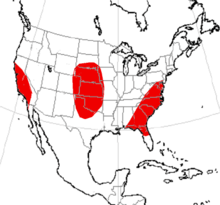Pediomeryx
| Pediomeryx | |
|---|---|
| Scientific classification | |
| Kingdom: | Animalia |
| Phylum: | Chordata |
| Class: | Mammalia |
| Order: | Artiodactyla |
| Family: | †Palaeomerycidae |
| Genus: | †Pediomeryx Stirton, 1936 |
| Species | |
| |
 | |
| Range of Pediomeryx based on fossil distribution | |
Pediomeryx is an extinct genus of Artiodactyla, of the family Palaeomerycidae, endemic to North America from the early Miocene epoch (Hemingfordian stage) 10.3—4.9 Ma, existing for approximately 5.4 million years.[1]
Taxonomy
Pediomeryx was named by Stirton (1936). It was assigned to Dromomerycidae by Stirton (1936) and Janis and Manning (1998); to Dromomerycinae by Hulbert and Whitmore (2006); and to Cranioceratini by Prothero and Liter (2007).[2][3][4]
Morphology
Body mass
A single fossil specimen of Pediomeryx was measured by M. Mendoza, C. M. Janis, and P. Palmqvist for body mass.[5]
- Specimen 1: 251 kg (550 lb)
Fossil distribution
Fossils have been recovered from the Midway Site in Florida, Saskatchewan, Boron, California, and several sites in Nebraska and Wyoming.
References
- ↑ PaleoBiology Database: Pediomeryx, basic info
- ↑ R. A. Stirton. 1936. Journal of Paleontology 10(7)
- ↑ C. M. Janis and E. Manning. 1998. Dromomerycidae. In C. M. Janis, K. M. Scott, and L. L. Jacobs (eds.), Evolution of Tertiary mammals of North America 477-490
- ↑ D. R. Prothero and M. R. Liter. 2007. Family Palaeomerycidae. in D. R. Prothero and S. Foss (eds.), The Evolution of Artiodactyls 241-248
- ↑ M. Mendoza, C. M. Janis, and P. Palmqvist. 2006. Estimating the body mass of extinct ungulates: a study on the use of multiple regression. Journal of Zoology 270(1):90-10
This article is issued from
Wikipedia.
The text is licensed under Creative Commons - Attribution - Sharealike.
Additional terms may apply for the media files.